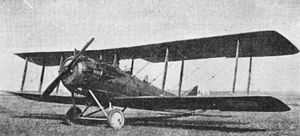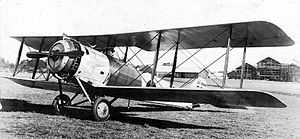Salmson 2
| Salmson 2 | |
|---|---|
 | |
| Salmson 2 | |
| Role | Reconnaissance biplane |
| Manufacturer | Salmson |
| First flight | 1917 |
| Number built | 3,200 |
|
| |
The Salmson 2, (given the military designation Salmson 2 A2) was a French biplane reconnaissance aircraft made by Salmson. It was developed to a 1916 requirement. Along with the Breguet 14, it was the main reconnaissance aircraft in use with the French army and the American Expeditionary Force's aviation units in 1918. At the end of the First World War, one-third of French reconnaissance aircraft were Salmson 2s.
Design and development
During the First World War, the Salmson factory built aircraft engines, generally 9- and later 18-cylinder water-cooled radial engines developed from the Swiss Canton-Unné design, one of the earliest known non-rotary radial engine designs ever used for military aircraft. The company's first entry into aircraft design came with the Salmson-Moineau S.M. 1, an unusual three-seat reconnaissance biplane with twin airscrews gear-driven from a single Salmson engine in the nose of the fuselage. These aircraft, of which 155 were built, were not especially successful.
The Salmson 2 developed from a requirement to replace the Sopwith 1½ Strutter and Dorand A.R. reconnaissance aircraft in the A2 (tactical reconnaissance) role. Salmson had built the 1½ Strutter under license, and the Salmson 2, while an original design, owed more to the Sopwith than to the earlier Salmson-Moineau. The aircraft was of conventional construction with a two-bay biplane configuration, powered by the company's own Salmson 9Z water-cooled radial engine of 230 bhp. Some minor control problems were quickly resolved in early testing, but the main defect of the Salmson 2, shared with the contemporary Airco DH.4, was that the pilot and gunner were seated rather far apart, making communication difficult. Production was ordered after trials on 29 April 1917, and deliveries were underway by October of that year. Around 3,200 Salmson 2s were built in France, 2,200 by Salmson and the remainder by the Latécoère, Hanriot, and Desfontaines, companies. Some of these were Salmson 2 D.2 dual control advanced training aircraft.
Variants
Developments of the Salmson 2 included:
- Salmson 4
- an enlarged version fitted with light armour, designed to meet the Ab 2 ground attack role. Limited production in 1918, but cancelled at the end of the war.
- Salmson 5
- modified Salmson 2 for A2 role, no production.
- Salmson 7
- modified Salmson 2 for A2 role. The main change was that the pilot and gunner were seated back-to-back in a single cockpit. Production was planned on a very large scale, but the end of the war resulted in cancellation of the contract.
- Salmson Limousine
- Also known as Salmson 2 Berline. After the First World War, a number of ex-military Salmson 2s were converted into civilian passenger aircraft.
Operational history
In addition to its service with the French army, the Salmson 2 served during the First World War with United States air units. Some 700 were purchased, and were generally successful.
Post-war, Salmson 2s were purchased by Czechoslovakia, and remained in service until 1924. Others were transferred to Poland, but were withdrawn by 1920, and replaced by Bristol F.2Bs. Japan undertook license production as the "Army Type Otsu 1", also known as the Kawasaki-Salmson. The number of aircraft built in Japan is unclear: 300 were built by Kawasaki, and the same quantity by the Imperial Japanese Army's Tokorozawa supply depot, although the total number of aircraft produced may have been as high as 1,000.
Military operators

Wartime
- American Expeditionary Force
Post-war
- Belgian Air Force - One aircraft only.
- Peruvian Air Force - One aircraft only.
- One aircraft only.
- Soviet Air Force
Survivors
- Kakamigahara Aerospace Museum, Kakamigahara, Gifu
Specifications
Data from Davilla and Soltan
General characteristics
- Crew: Two, pilot and gunner
- Length: 8.5 m (27 ft 10½ in)
- Wingspan: 11.75 m (38 ft 6½ in)
- Height: 2.9 m (9 ft 6 in)
- Wing area: 37.27 m² (401 ft²)
- Empty weight: 780 kg (1,716 lb)
- Loaded weight: 1,290 kg (2,838 lb)
- Powerplant: 1 × Salmson 9Za radial piston engine, 172 kW (230 hp)
Performance
- Maximum speed: 188 km/h (101 knots, 116 mph) at sea level
- Range: 500 km (270 nm, 310 mi)
- Service ceiling: 6,250 m (20,500 ft)
- Time to altitude: 2,000 m (6,562 ft) in 7 minutes 13 seconds[1]
Armament
- Guns:
- 1 × forward synchronized 0.303 in Vickers machine gun
- 2 × rear, ring-mounted 0.303 in Lewis Guns
References
| Wikimedia Commons has media related to Salmson 2. |
- Davilla, James J., & Soltan, Arthur M., French Aircraft of the First World War. Stratford, Connecticut: Flying Machines Press, 1997. ISBN 0-9637110-4-0
- Owers, Colin A.; Jon S. Guttman & James J. Davilla (2001). Salmson aircraft of World War I. Boulder, Colorado. p. 26. ISBN 1 891268 16 3.
| ||||||||||||||||||||||